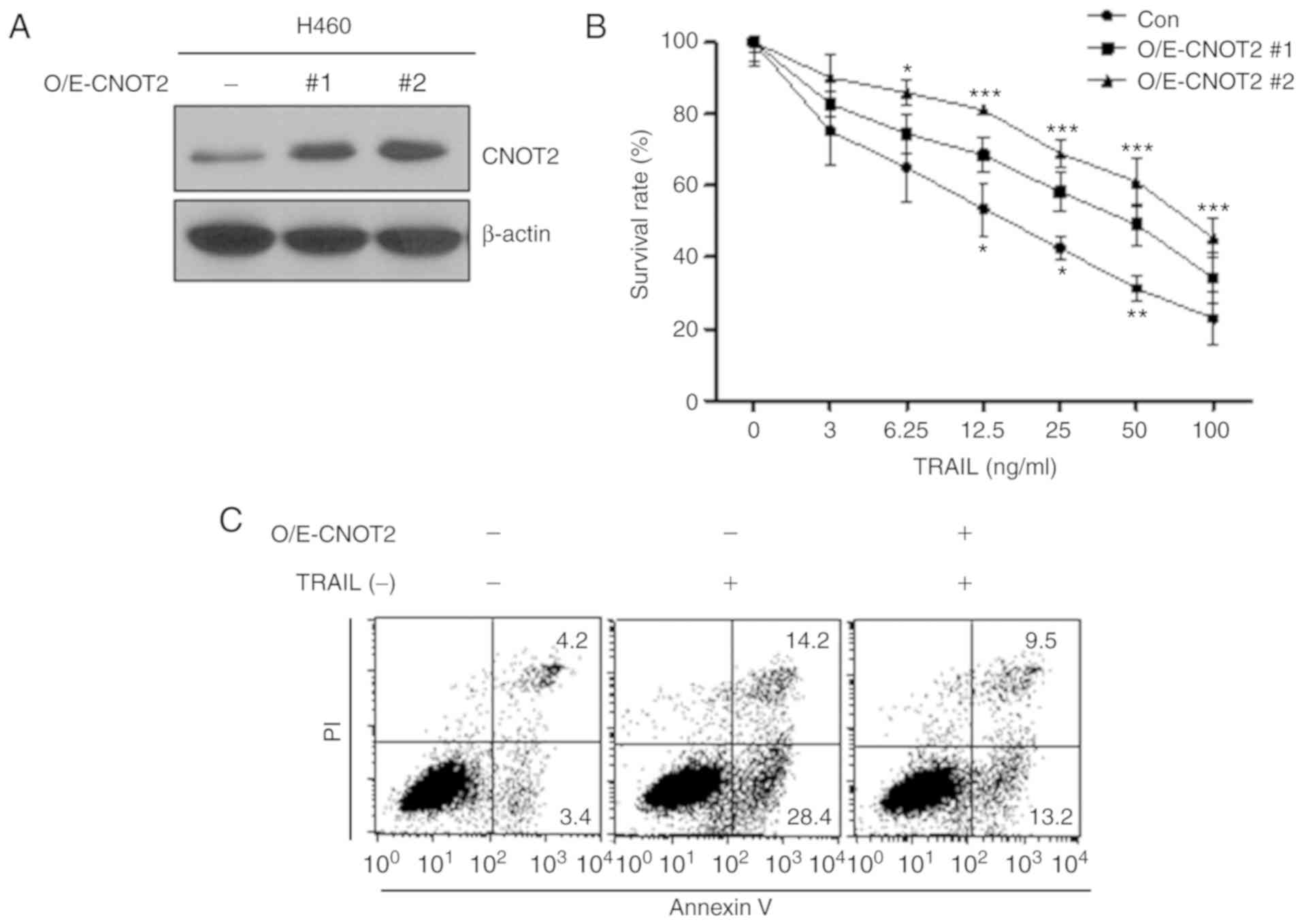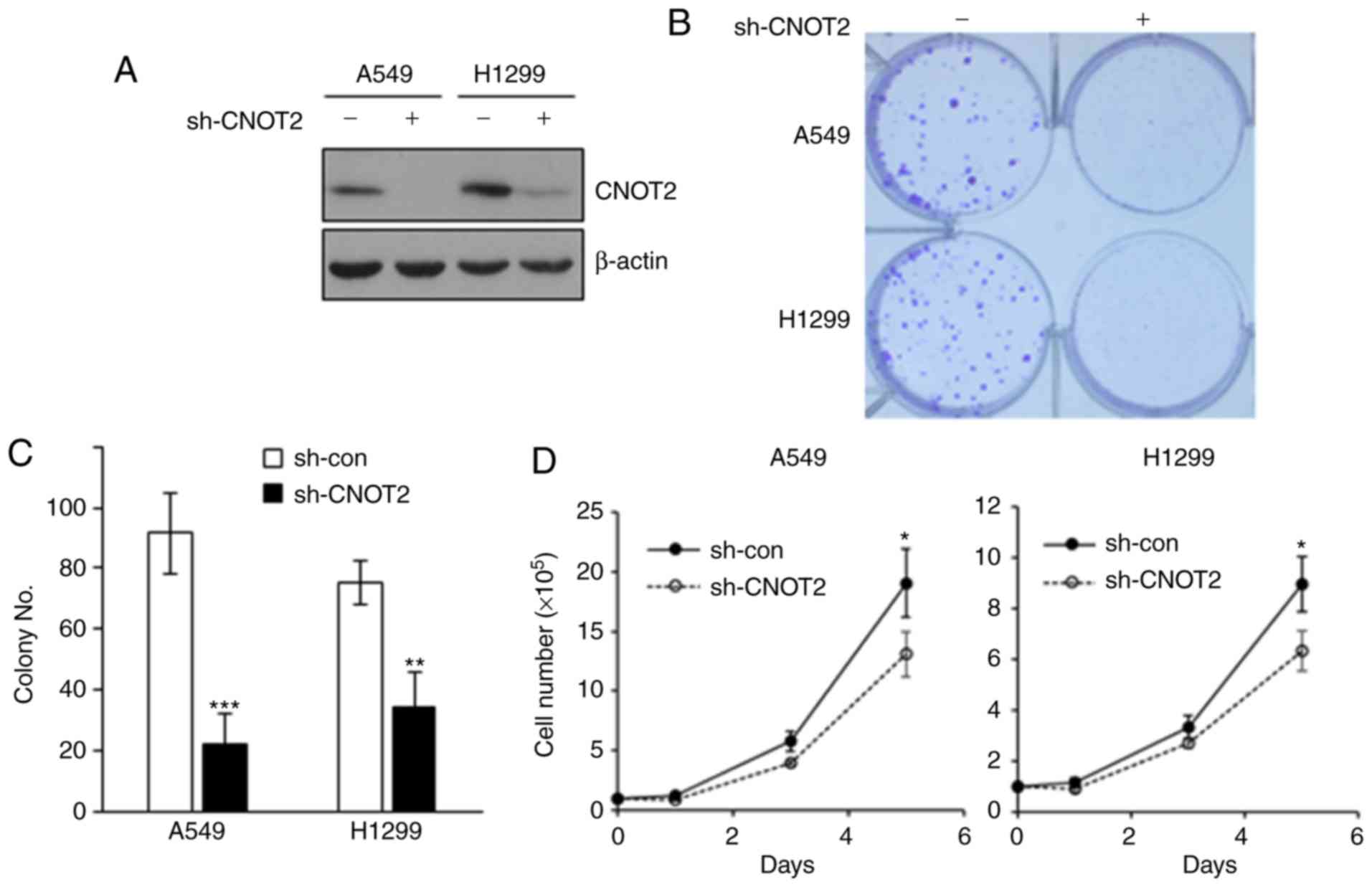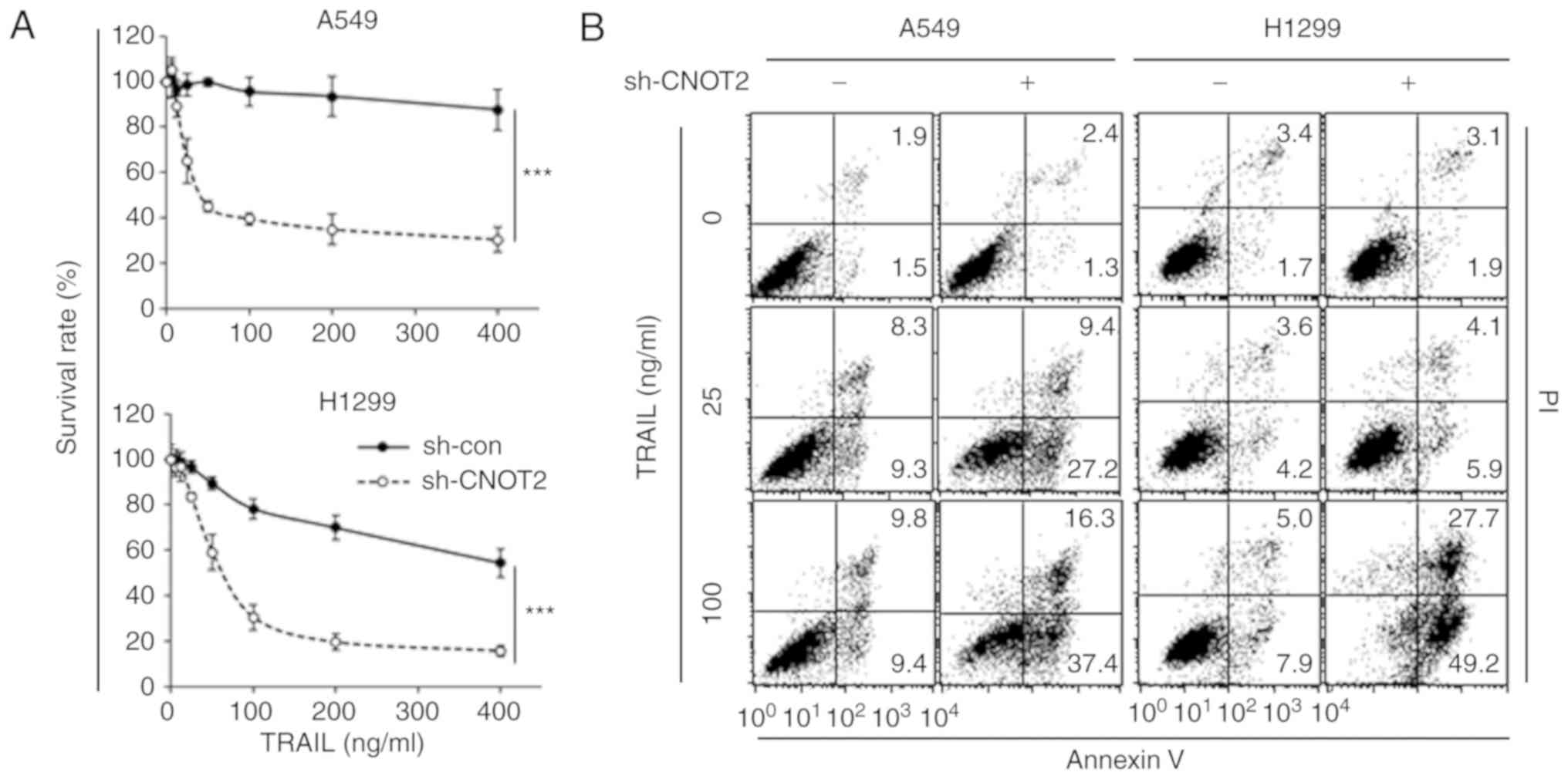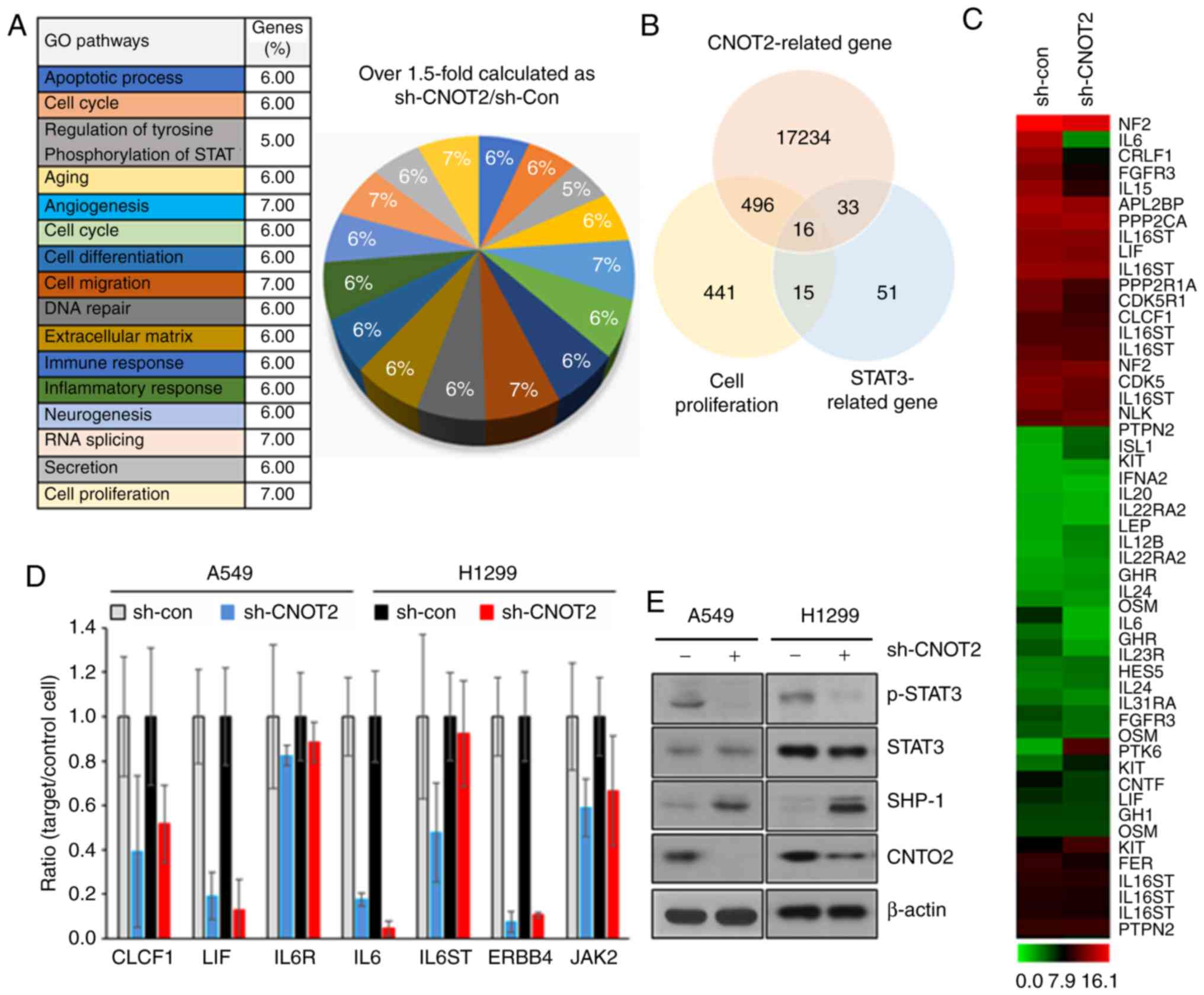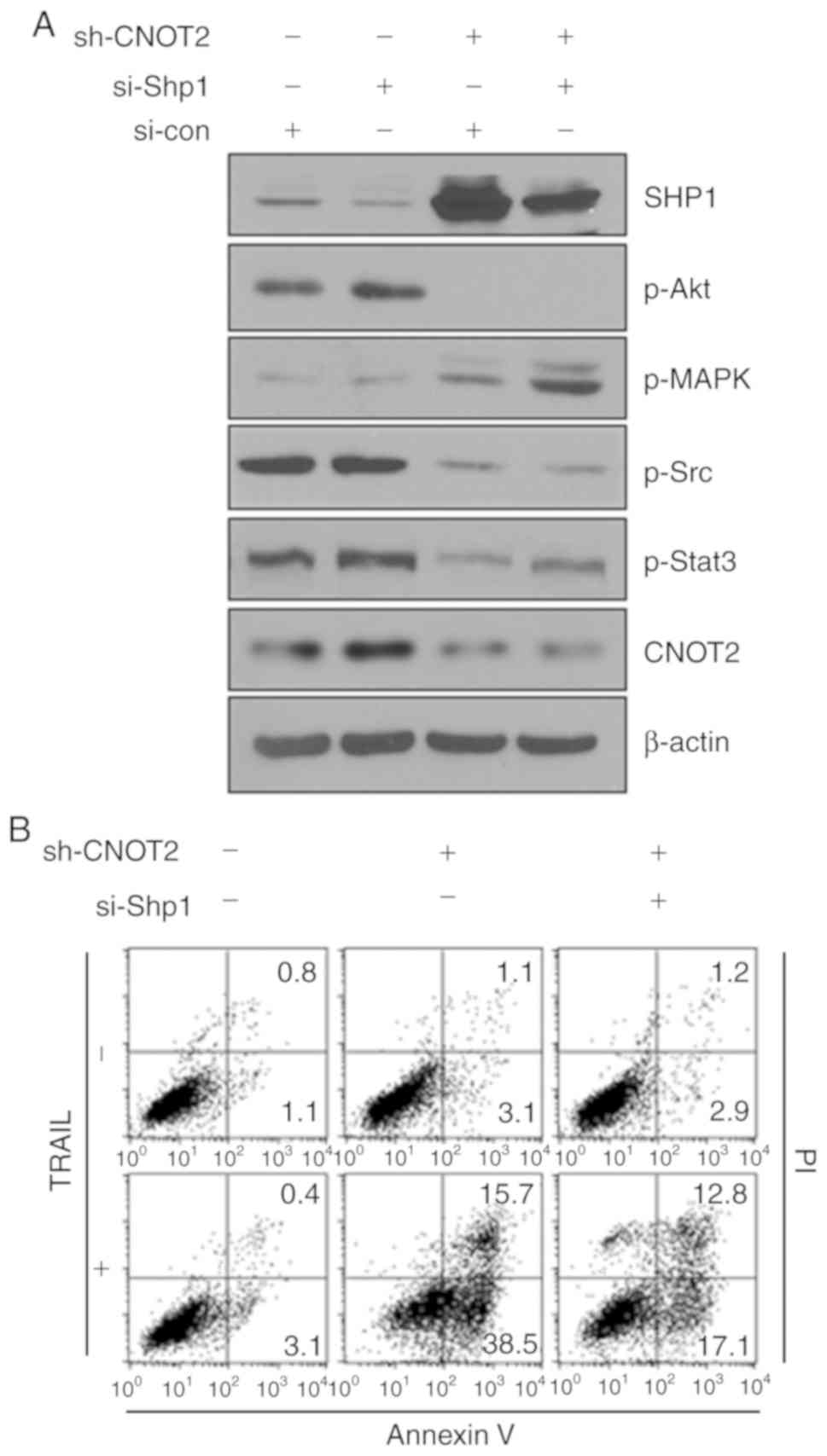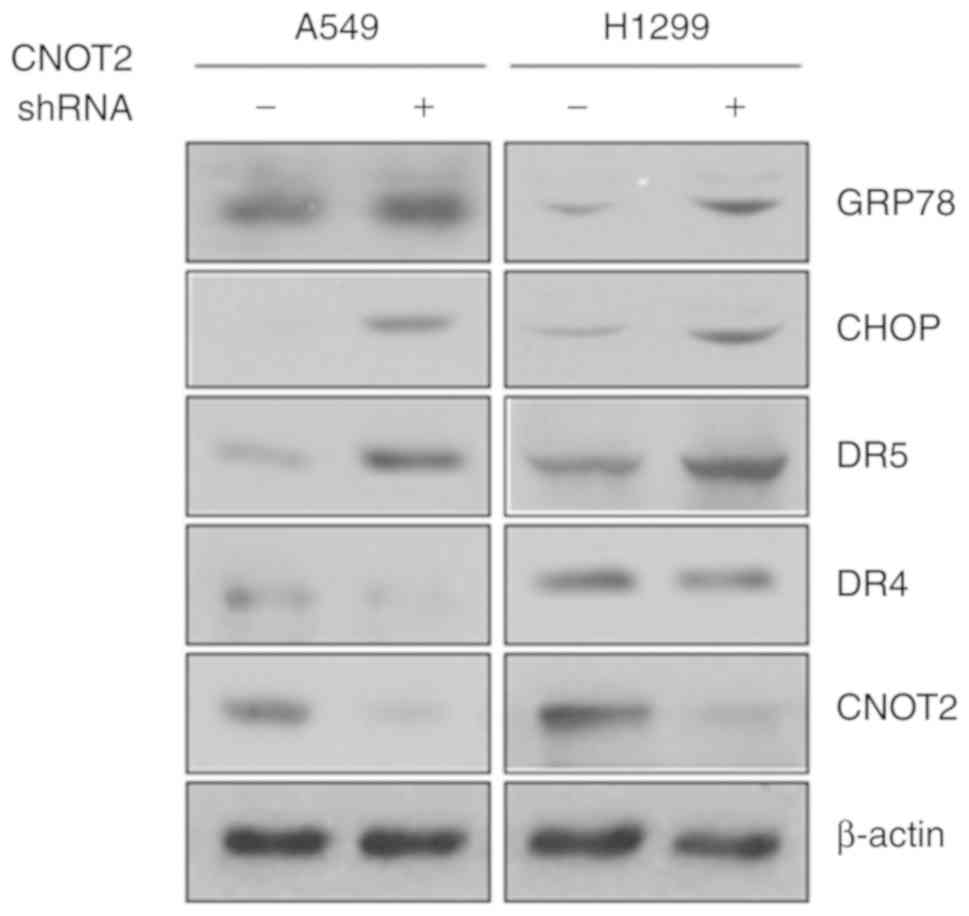CCR4‑NOT transcription complex subunit 2 regulates TRAIL sensitivity in non‑small‑cell lung cancer cells via the STAT3 pathway
- Authors:
- Published online on: December 12, 2019 https://doi.org/10.3892/ijmm.2019.4425
- Pages: 324-332
-
Copyright: © Kim et al. This is an open access article distributed under the terms of Creative Commons Attribution License.
Abstract
Introduction
Lung cancer is the most prevalent type of cancer worldwide, leading annually to the deaths of more than 1.76 million individuals (1). Non-small-cell lung cancer (NSCLC) is the major type of lung adenocarcinoma found in approximately 85% of all cases of lung cancer, with the majority of patients presenting with advanced tumor stages in the United States (2). Even though numerous types of treatment strategies including immunotherapy, chemotherapy, radiotherapy and combination therapy have been developed for NSCLC, the 5-year survival rate for patients with advanced stages of the disease (with metastasis) has only marginally improved over the past 4 decades, remaining at approximately 4% (3). Therefore, the development of novel therapeutic strategies for NSCLC is of utmost importance.
TNF-related apoptosis-inducing ligand (TRAIL) is often referred to as a ʻmagic bulletʼ as it can specifically target a broad range of tumors, including lung cancer, while avoiding detrimental effects on normal cells. TRAIL is a potent apoptotic inducer capable of binding to the death receptors, death receptor (DR)4 and DR5, which can subsequently activate an apoptotic signal pathway known as the extrinsic apoptotic pathway (4). However, a number of types of tumors evade TRAIL-mediated apoptosis, such as via an increase in the expression of anti-apoptotic molecules, by the downregulation of apoptotic proteins, or with the inhibition of apoptotic signaling pathways, leading to TRAIL resistance (5,6). To overcome this resistance, several methods have used, such as the modulation of apoptosis-related proteins or treatment with chemotherapeutic drugs, leading to an increase in TRAIL sensitivity.
CCR4-NOT transcription complex (CNOT), composed of 11 subunits, participates in ribonucleic acid (RNA) regulation, including messenger RNA (mRNA) stability and export. In particular, CNOT2, one of the CCR4-NOT subunits, plays a critical role in deadenylase activity and the structural integrity of the complex (7). In addition, this protein participates in embryonic development and transcriptional regulation via the recruitment of histone modifiers (8,9). Recent studies have suggested that CNOT2 plays important roles in tumor progression, such as in metastasis, proliferation and angiogenesis via the regulation of vascular endothelial growth factor signaling in breast cancer cells (10,11). However, to the best of our knowledge, CNOT2 has not been evaluated as a molecular target for tumor treatment to date. Hence, in the current study, the therapeutic potential through which the suppression of CNOT2 enhances TRAIL sensitivity in TRAIL-resistant NSCLC cells through the STAT3 signaling pathway was examined.
Materials and methods
Cells and cell culture
All cell culture experiments adhered to standard biosafety level 2 guidelines. All cell lines used in this study were tested for mycoplasma contamination using a mycoplasma detection kit (JCBIO). The NSCLC cell lines, A549, H1299, H596 and H460, were purchased from the Korean Cell Line Bank. The NSCLC cells were cultured in Roswell Park Memorial Institute 1640 (RPMI-1640; Corning Inc.), supplemented with 10% fetal bovine serum (Corning Inc.) and 1% penicillin-streptomycin (Corning Inc.). All cells were cultured in a 37°C humidified atmosphere containing 5% CO2.
Reagents and antibodies
TRAIL/Apo2L (ABIN2973530) was purchased from Atgen. The antibodies for cleaved caspase-3 (sc-56053), caspase-3 (sc-7148), Src homology region 2 domain containing phosphatase-1 (SHP1) (sc-8425), DR4 (sc-8411), BCL2 associated X protein (Bax) (sc-7480) and PARP[poly(ADP-ribose) polymerase] (sc-7150) were purchased from Santa Cruz Biotechnology, while phospho-signal transducer and activator of transcription 3 (STAT3) (#9131), STAT3 (#12640), phospho-Akt(#9271), phosphor-mitogen-activated protein kinase (MAPK) (#9101), phospho-Src (#2105), Bcl-2 (#15071), DR5 (#3696), C/EBP homologous protein (CHOP) (#2895), glucose-regulated protein 78 (GRP78) (#3177) and β-actin (#4967) antibodies were purchased from Cell Signaling Technology. Finally, the antibodies for CNOT2 (ab55679) and cytochrome c (ab13575) were purchased from Abcam.
Cytotoxicity assay
Cell cytotoxicity was measured by way of the 3-(4,5-dimethylthialzol-2-yl)-2,5-diphenyl-2H-tetrazolium bromide (MTT) assay. MTT was purchased from Molecular Probes. The NSCLC cells were seeded in 96-well plates at a density of 0.7×104 cells per well and incubated with various concentrations (0, 3.12, 6.25, 12.5, 25, 50, 100, 200 and 400 ng/ml) of TRAIL for 24 h at 37°C. The viability of the cells was analyzed as previously described (12,13). Optical density was measured using a microplate reader (VersaMax; Molecular Devices) at 570 nm and data were analyzed using the Softmax Pro software program (Molecular Devices). The results are expressed as the means and standard deviations after at least 3 independent experiments performed in triplicate.
Apoptosis assay
Apoptosis was measured by flow cytometry after staining with Annexin V-FITC and propidium iodide (PI). The cells (2×105) were incubated with 0, 25 and 100 ng/ml of TRAIL for 24 h at 37°C prior to analysis. The cells were stained using an Annexin V-FITC apoptosis detection kit (Biovision) according to the manufacturer's instructions. Apoptotic cells were measured using the FACSCalibur platform (BD Biosciences). Data were analyzed using the Cell Quest program (BD Biosciences). The experiment was repeated in triplicate.
Stable cell lines
To establish a stable CNOT2-overexpressing H460 cell line, the cells were seeded in the manner of 1.5×105 cells in 6-well plates at 1 day prior to transfection. Transfection was performed using pcDNA3.1-CNOT2 and vector with X-treme GENE HP DNA transfection reagent (Roche Holding AG), following the manufacturer's instructions. Following 72 h of transfection, the cells were treated with 500 µg/ml of G418 (Sigma-Aldrich) every 2 days for 10 days total to establish a stable cell line.
To ensure the stable knockdown of CNOT2 in the NSCLC cells, the A549, H1299 and H596 cells were transfected with pRS vector containing CNOT2 shRNA (cat. no. TF81001; OriGene Technologies, Inc.) or control shRNA (Cat. no. TF81001; OriGene Technologies, Inc.). After transfection, the cells were incubated for 2 days followed by selection with 1.5 to 2 µg/ml puromycin for 3-5 days. Thereafter, cells were cultured with normal media.
Transfection with siRNA
SHP1 siRNA and control siRNA were designed and purchased from Santa Cruz Biotechnology. At 1 day prior to transfection, the cells were seeded in the manner of 1×105 cells in a 6-well plate and incubated at 37°C. The cells were transfected using the INTERFERin in vitro siRNA transfection reagent (Polyplus-transfection SA) according to the manufacturer's instructions. The mixture was applied to the cells and incubated for 48 h at 37°C in the presence of 5% CO2.
Colony-forming assay
The cells were seeded in the manner of 5×102 cells in 6-well plates and incubated for 7 days at 37°C in the presence of 5% CO2. Subsequently, 10% buffered formaldehyde (Sigma-Aldrich) was added to the cells followed by incubation for 10 min at room temperature, while 1 ml of 0.1% crystal violet (Sigma-Aldrich) was also added to the cells and shaken for 30 min at room temperature. The cells were washed 3 times with distilled water and dried.
Cell count
The cells were seeded in the manner of 1×105 cells in six6well plates and incubated for 7 days at 37°C in the presence of 5% CO2. The numbers of cells were counted using a light microscope (Olympus) and a hemocytometer (Hausser Scientific Co.).
Reverse transcription-quantitative polymerase chain reaction (RT-qPCR)
Total RNA was extracted from the cells using TRIzol reagent. Cells were mixed with 1 ml of TRIzol (Invitrogen; Thermo Fisher Scientific) and incubated at room temperature for 10 min following vortexing. Subsequently, 300 µl of chloroform was mixed gently by inverting. Centrifugation was performed at 12,000 × g for 15 min at 4°C and the resultant supernatant was collected. At this point, an equal amount of isopropanol was added, mixed gently, and incubated at room temperature for 10 min. Centrifugation was performed for 20 min at 10,000 × g at 4°C to remove the supernatant. After washing with 70% ethanol, the RNA pellet was dissolved in diethyl pyrocarbonate (DEPC) water. The RNA concentration and purity of each sample were determined using a NanoDrop 2000C spectrophotometer (Thermo Fisher Scientific). Complementary DNA (cDNA) was synthesized using the PrimeScript first-strand cDNA synthesis kit (Takara Korea Biomedical Inc.) according to the manufacturer's instructions. The amplification of each cDNA was monitored using the Sensi FAST SYBR No-ROX kit (Bioline) on a StepOnePlus instrument (Thermo Fisher Scientific). All specific forward and reverse primers used were as follows: Cardiotrophin-like cytokines factor 1 (CLCF1), forward, 5′-TAT GAC CTC ACC CGC TAC CT-3′ and reverse, 5-′GGG GCC CAG GTA GTT CAG-3′; interleukin (IL)6 forward, 5′-CCA CCG GGA ACG AAA GAG AA-3′ and reverse, 5′-GAG AAG GCA ACT GGA CCG AA-3′; IL6 receptor (IL6R) forward, 5′-GGG TCT CTA CCA TCC CCT GT-3′ and reverse, 5′-AGA AAT GGC AGA AGC CCT CC-3′; IL6 signal transducer (IL6ST) forward, 5′-CAG TGG TCA CCT CAC ACT CC-3′ and reverse, 5′-TGA CAT GCA TGA AGA CCC CC-3′; Janus kinase 2 (JAK2) forward, 5′-TGG GGT TTT CTG GTG CCT TT-3′ and reverse, 5′-TAG AGG GTC ATA CCG GCA CA-3′; leukemia inhibitory factor (LIF) forward, 5′-CTC GCC CAT CAC CTC ATC TC-3′ and reverse, 5′-GCA GAG CTG TTT CAC GCA AA-3′; Erb-B2 receptor tyrosine kinase 4 (ERBB4) forward, 5′-CCT GGA AGA AAG ACG ACT CGT TC-3′ and reverse, 5′-CGT CAC TCT GAT GGG TGA ATT TCC-3′; and glyceraldehyde-3-phosphate dehydrogenase (GAPDH) forward, 5′-CTG CAC CAC CAA CTG CTT AG-3′ and reverse, 5′-AGG TCC ACC ACT GAC ACG TT-3′. GAPDH was used as an internal control. The relative mRNA expression change was expressed as a fold change in comparison with the GAPDH control. Data are presented as the means ± standard deviations from at least 3 independent experiments in triplicate.
RNA isolation and gene expression profiling
In the present study, we performed global gene expression analyses using Affymetrix GeneChip® Human Gene 2.0 ST oligonucleotide arrays. Total RNA was isolated from the CNOT2-depleted or control sh-RNA transfected-A549 cells using TRIzol reagent (Qiagen). RNA quality was assessed with the Agilent 2100 Bioanalyser (Agilent Technologies) and quantity was determined with the ND-2000 spectrophotometer (Thermo Fisher Scientific). For each RNA, the synthesis of target cRNA probes and hybridization were performed using Agilent's Low-input QuickAmp Labeling kit (Agilent Technologies) according to the manufacturer's instructions. The gene expression data were analyzed using GeneSpringGX 7.3.1 software (Agilent Technologies). A hierarchically clustered heatmap was generated using MeV version 4.9.0 software. The genes related to cell proliferation [Gene Ontology (GO):0008283) and STAT3 GO:0042509] were classified and visualized in a Venn diagram. Gene array hybridization raw data were deposited in the National Center for Biotechnology Information Gene Expression Omnibus database under accession no. GSE131518.
Western blot analysis
The cells were rinsed with ice-cold PBS and harvested with a cell scraper followed by centrifugation at 300 × g for 5 min at 4°C. The cell pellets were lysed as previously described (13,14). Protein samples were quantified by using a Bio-Rad DC protein assay kit II (Bio-Rad) and 10-20 µg of protein lysates were separated on 8 to 15% sodium dodecyl sulfate-polyacrylamide gels and transferred to polyvinylidene difluoride membranes (Millipore). The membranes were blocked in 5% nonfat skim milk (in TBST buffer) for 1 h at RT and then probed with primary antibodies at 1/1,000-2,000 diluted in 3-5% non-fat skim milk for 1 h at room temperature. After washing 3 times for 5 min with TBST, the membranes were incubated with horseradish peroxidase-conjugated secondary antibodies (#7076 for anti-mouse, #7074 for anti-rabbit from Cell Signaling Technology), 1/5,000 diluted in 5% non-fat skim milk, for 1 h at room temperature. The protein expression levels were detected using an enhanced chemiluminescence (ECL) system (Amersham Pharmacia), according to the manufacturer's instructions.
Statistical analysis
All experiments were repeated 3 times. Data are presented as the means ± standard deviation (SD). Differences between the means of each group were analyzed using a t-test, while P-values <0.05 were considered significant to indicate statistically significant differences. The statistical software package Excel (Microsoft Corp.) was used for the analysis. The Prism software package (Graph Pad Prism 5.0 for Windows) was used for data collection and presentation for Fig. 3B. The data ranged from 3 to 12 separate experiments and are presented as the means ± SD. Two-way ANOVA followed by a Bonferroni post hoc test were used to determine the significant differences between the various experimental and control groups.
Results
Depletion of CNOT2 affects the proliferation and growth of NSCLC cells
To determine whether CNOT2 has an oncogenic function in NSCLC similar to that in other cancer types as we previously demonstrated (15), we depleted CNOT2 using specific shRNA in the NSCLC cell lines, A549 and H1299 (Fig. 1A). We found that the knockdown of CNOT2 resulted in a 50 to 75% decrease in colony number (Fig. 1B and C) and an approximately 40% decrease in the growth rates of NSCLC cells (Fig. 1D). These results indicate that CNOT2 affects the proliferation and growth of NSCLC cells.
Knockdown of CNOT2 markedly increases TRAIL sensitivity in A549 and H1299 cells
To explore whether CNOT2 participates in the regulation of TRAIL sensitivity, the cells in which CNOT2 was downregulated were treated with TRAIL (Figs. 2A and S1). As shown in Figs. 2A and S1B, treatment with TRAIL markedly decreased the survival rates of cells when compared with the control in the A549, H1299 and H596 cells. TRAIL treatment enhanced apoptosis, the main death mechanism promoted by TRAIL, in a dose-dependent manner in the CNOT2-depleted cells (Fig. 2B). These results indicate that CNOT2 participates in the TRAIL-mediated apoptosis of NSCLC cells.
CNOT2 overexpression increases TRAIL resistance in the TRAIL-sensitive cell line, H460
To confirm that CNOT2 participates in TRAIL sensitivity in NSCLC, we established a CNOT2-overexpressing H460 line that is TRAIL-sensitive (Fig. 3A). Treatment of the CNOT2-overexpressing cells with TRAIL increased the cell survival rates by 1.2- to 1.7-fold, as compared with the control cells (Fig. 3B). In addition, the CNOT2-overexpressing cells exhibited decreased apoptosis following treatment with TRAIL (Fig. 3C). These data suggest that the increase in CNOT expression imparts TRAIL resistance on TRAIL-sensitive cells.
CNOT2 depletion downregulates the SHP1/STAT3 signaling pathway
To validate the gene expression profiles and molecular mechanisms involved in CNOT2-mediated TRAIL sensitivity, we analyzed GO pathways in CNOT2-silenced A549 cells using a cDNA microarray. CNOT2 depletion induced dominant changes in the pathways of cell migration, angiogenesis, RNA splicing and cell proliferation (Figs. 4A and S2). In previous studies, it was demonstrated that CNOT2 is highly associated with angiogenesis, migration and metastasis in various cancer types (11,16-18). In this study, we focused on proliferation, which was also altered in CNOT2-depleted lung cancer cells (Fig. 4B). Sixteen genes regulated by CNOT2 depletion were commonly STAT3-related genes, involved in cell proliferation and CNOT2-related genes (Fig. 4C). Consistent with these findings, RT-qPCR analysis confirmed that the inhibition of CNOT2 downregulated the gene expression levels of IL6 and CLCF1 as tumor progression markers and STAT3-related genes (19,20) as well as LIF and ERBB4 as proliferation markers (21,22) in A549 and H1299 cells (Fig. 4D). In the same analysis, IL6ST, IL6R and JAK2, as STAT3-related genes without differences in CNOT2-depleted cells, were confirmed (Fig. 4C and D). Subsequently, STAT3 activity was also verified by measuring the phosphorylation level of STAT3 in CNOT2-depleted cells. As shown in Fig. 4E, the phosphorylation of STAT3 was significantly decreased, while STAT3 protein expression was not altered in the A549 or H1299 cells in which CNOT2 expression was silenced. In addition, we found that SHP1 was dramatically upregulated in the same sample (Fig. 4E). To verify whether SHP1 plays an important role in CNOT2-mediated gene regulation, we inhibited the SHP1 gene in CNOT2-depleted cells. The inhibition of SHP1 increased the phosphorylation of STAT3 as compared with the control (Fig. 5A) and recovered the survival rates of CNOT2-depleted cells (Fig. 5B). These results indicate that STAT3 is a main regulator of the CNOT2-mediated signaling pathway.
Inhibition of CNOT2 increases endoplasmic reticulum (ER) stress
Recent studies have indicated that STAT3 and ER stress signaling pathways interact with each other through diverse mechanisms, leading to the control of cellular fate (23,24). Thus, it was hypothesized that STAT3 inactivation by the depletion of CNOT2 may affect the ER stress signaling pathway. To examine this hypothesis, we validated the expression level of ER stress signaling molecules. As shown in Fig. 6, CNOT2 depletion induced the expression of GRP78, CHOP and DR5, ER stress-related molecules, but not that of DR4 in the A549 and H1299 cells. These results suggest that the CNOT2-mediated STAT3 signaling pathway is closely associated with ER stress, but not apoptosis.
Discussion
In the current study, the findings demonstrated that the depletion of CNOT2 induced the TRAIL-mediated apoptosis of various TRAIL-resistant NSCLC cells. These increases in TRAIL sensitivity by CNOT2 depletion were mediated by the induction of ER stress, leading to the upregulation of DR5. In addition, it was demonstrated that CNOT2 may participate in STAT3 signaling via the regulation of SHP1 expression.
TRAIL is a promising molecule which can be used to kill tumors, even though the majority of tumors present acquired resistance against TRAIL-mediated cell death. Following the binding of TRAIL to death receptors, DR4 and DR5 receptors are clustered by the recruitment of Fas-associated protein with death domain (FADD), which initiates the extrinsic apoptotic signaling pathway (25). Subsequently, FADD recruits caspase-8 to form the death-inducing signaling complex (DISC), leading to the cleavage of caspase-3, -6 and -7 (25-27). The activation of these caspases induces apoptotic phenotypes, such as membrane blebbing, cleavage of proteins and the cytoskeleton, and DNA fragmentation. In addition, recruited caspase-8 activates the intrinsic apoptotic pathway in certain instances, such as for example, the Bax/Bcl-2 pathway (28).
However, tumors, including lung cancer tumors usually have a number of evasive tactics against TRAIL-induced apoptosis. One typical evasive strategy of various tumors is the upregulation of the anti-apoptotic proteins, Bcl-2, Bcl-xL, induced myeloid leukemia cell differentiation protein (Mcl-1), BHRF1 and E1b-19K (5). More than 50% of cancer types possess overexpressed Bcl-2 (29) and XIAP is upregulated in various types of cancer (6). The other evasion mechanism involves the downregulation of pro-apoptotic or apoptosis-inducing proteins, such as p53, caspases, PARP, Bax and the tumor necrosis factor receptor family, including DR4 and DR5 (30-33). For example, the expression levels of caspases, including caspase-8 are decreased in a diverse range of tumor cells (6,34). Mutations in the p53 gene have been reported in up to 25% of tumors (35) and the upregulation of p53 isoforms leading to the inactivation of the canonical p53 function has also been found in tumors (36).
To overcome these evasion strategies against apoptosis, diverse combination therapies with TRAIL and agents to either increase TRAIL activity or sensitize TRAIL-resistant cells have been considered. A number of phytochemicals can modulate the expression of various proteins to increase TRAIL efficiency. For example, decursin enhances TRAIL-induced apoptosis through the upregulation of ER stress-mediated DR5 in lung cancer cells (12). Another approach is to modulate genes regulating apoptosis-related proteins, leading to an increased susceptibility to TRAIL efficiency. The depletion of calcium and integrin-binding protein 1 (CIB1), regulators of oncogenic PI3K/AKT and MET/ERK signaling, with TRAIL enhances the apoptosis of triple-negative breast cancer cells (37).
Similar to CIB1, in the case of proteins with an oncogenic or tumor suppressor function, the modulation of the expression may affect TRAIL-mediated cell death. As previously demonstrated, CNOT2 participates in the regulation of angiogenesis, mobility autophagy and proliferation in diverse tumor types (11,15). Based on these oncogenic functions of CNOT2, it was hypothesized that CNOT2 may participate in TRAIL-resistant mechanisms. Consistently, the depletion of CNOT2 with TRAIL also markedly increased the apoptotic rate of TRAIL-resistant lung cancer cells.
STAT3 is a well-documented oncogenic transcription factor that participates in diverse cellular signaling pathways, including proliferation, apoptosis and cell growth (38,39). In various malignant tumors, STAT3 signaling is constitutively activated, enhancing tumorigenesis (40,41). SHP1, a non-receptor protein tyrosine phosphatase, is a major negative regulator by the dephosphorylation of STAT3 (42). A number of studies have indicated that the constitutive activation of STAT3 in various tumor types is prompted by diminished or abolished SHP1 expression (43,44). Therefore, the induction of SHP1 expression in cancer may be an effective method with which to diminish tumors via the inactivation of STAT3. In this aspect, CNOT2 may be an attractive target which may be used to boost SHP1 expression. Nakase et al reported that Sp1, Oct-1, NF-κB and CREB-1 interacted with the core SHP1 P2 promoter in CD4+ T-cells and Jurkat cells (45). Previously, Warner et al suggested that CNOT2 depletion affected NF-κB expression (46). These two results indicate that CNOT2 may regulate SHP1 expression through the NF-κB signaling pathway. However, further detailed studies are required to better elucidate the mechanisms through which CNOT2 regulates SHP1.
Recent studies have suggested that the STAT signaling pathway may be connected with ER stress (23,24,47). Based on the findings of this study, under a CNOT2-depleted condition in NSCLC cells, SHP1 and ER stress molecules were concurrently increased. In addition, the inhibition of SHP1 suppressed apoptosis induced by TRAIL and CNOT2 depletion in NLCLC cells. However, this study was not able to obtain any direct evidence to connect STAT3 and ER stress in CNOT2-depleted NSCLC cells (data not shown). Further studies are warranted to address this issue.
Taken together, the depletion of CNOT2 highly induces the TRAIL-mediated apoptosis of various TRAIL-resistant NSCLC cells. These increases in TRAIL sensitivity by CNOT2 depletion are mediated by the induction of ER stress, leading to the upregulation of DR5. In addition, this study demonstrated that CNOT2 may participate in STAT3 signaling via the regulation of SHIP1 expression.
Supplementary Data
Abbreviations:
|
TRAIL |
TNF-related apoptosis-inducing ligand |
|
CNOT2 |
CCR4-NOT transcription complex subunit 2 |
|
NSCLC |
non-small cell lung cancer |
|
DR4 |
death receptor 4 |
|
DR5 |
death receptor 5 |
|
HNSCC |
head and neck squamous cell carcinoma |
|
STAT3 |
signal transducer and activator of transcription 3 |
|
FBS |
fetal bovine serum |
|
SHP1 |
Src homology region 2 domain containing phosphatase-1 |
|
Bax |
BCL2 associated X protein |
|
PARP |
poly(ADP-ribose) polymerase |
|
MAPK |
mitogen-activated protein kinase |
|
Bcl-2 |
B-cell lymphoma 2 |
|
CHOP |
C/EBP homologous protein |
|
GRP78 |
glucose-regulated protein 78 |
|
MTT |
3-(4,5-dimethylthialzol-2-yl)-2,5-diphenyl-2H-tetrazolium bromide |
|
PI |
propidium iodide |
|
RNA |
ribonucleic acid |
|
DEPC |
diethyl pyrocarbonate |
|
GAPDH |
glyceraldehyde-3-phosphate dehydrogenase |
|
ECL |
enhanced chemiluminescence |
|
RT-qPCR |
reverse transcription-quantitative polymerase chain reaction |
|
IL6 |
interleukin 6 |
|
IL6R |
interleukin 6 receptor |
|
CLCF1 |
cardiotrophin-like cytokines factor 1 |
|
LIF |
leukemia inhibitory factor |
|
ERBB4 |
Erb-B2 receptor tyrosine kinase 4 |
|
IL6ST |
interleukin 6 signal transducer |
|
JAK2 |
Janus kinase 2 |
|
ER |
endoplasmic reticulum |
|
FADD |
Fas-associated protein with death domain |
|
DISC |
death-inducing signalling complex |
Acknowledgments
Not applicable.
Funding
This study was supported by the National Research Foundation of Korea (NRF) Grant funded by the Korea Government (Ministry of Science and ICT) (NRF-2018R1D1A1B07048377 and NRF-2016R1D1A1B03933853).
Availability of data and materials
The datasets supporting the conclusions of this article are included within the article and its additional files.
Authors' contributions
EOK was involved in acquisition, analysis and interpretation of the data and development of the methodology. SEK was involved in the acquisition of data. MC contributed to the acquisition and analysis of the data during revision. KJR was involved in the analysis of the data and revised critically for important intellectual content. MY was involved in the analysis and interpretation of the data and the writing of the manuscript, conception and design of the study, and funding. All authors discussed the results, commented on the manuscript, and approved the final submitted and published versions. In addition, all authors agree to be accountable for all aspects of the work in ensuring that questions related to the accuracy or integrity of any part of the work are appropriately investigated and resolved.
Ethics approval and consent to participate
Not applicable.
Patient consent for publication
Not applicable.
Competing interests
The authors declare no that they have no competing interests.
References
|
World Health Organization: Cancer. https://www.who.int/news-room/fact-sheets/detail/cancer. Accessed September 12, 2018. | |
|
Warth A, Muley T, Herpel E, Meister M, Herth FJ, Schirmacher P, Weichert W, Hoffmann H and Schnabel PA: Large-scale comparative analyses of immunomarkers for diagnostic subtyping of non-small-cell lung cancer biopsies. Histopathology. 61:1017–1025. 2012. View Article : Google Scholar : PubMed/NCBI | |
|
Noone AM, Howlader N, Krapcho M, Miller D, Brest A, Yu M, Ruhl J, Tatalovich Z, Mariotto A, Lewis DR, et al: SEER Cancer Statistics Review, 1975-2015. National Cancer Institute Bethesda; MD: 2018 | |
|
Schneider P, Thome M, Burns K, Bodmer JL, Hofmann K, Kataoka T, Holler N and Tschopp J: TRAIL receptors 1 (DR4) and 2 (DR5) signal FADD-dependent apoptosis and activate NF-kappaB. Immunity. 7:831–836. 1997. View Article : Google Scholar | |
|
Adams JM and Cory S: The Bcl-2 protein family: Arbiters of cell survival. Science. 281:1322–1326. 1998. View Article : Google Scholar : PubMed/NCBI | |
|
Elkholi R, Renault TT, Serasinghe MN and Chipuk JE: Putting the pieces together: How is the mitochondrial pathway of apoptosis regulated in cancer and chemotherapy? Cancer Metab. 2:162014. View Article : Google Scholar | |
|
Russell P, Benson JD and Denis CL: Characterization of mutations in NOT2 indicates that it plays an important role in maintaining the integrity of the CCR4-NOT complex. J Mol Biol. 322:27–39. 2002. View Article : Google Scholar : PubMed/NCBI | |
|
Zwartjes CG, Jayne S, van den Berg DL and Timmers HT: Repression of promoter activity by CNOT2, a subunit of the transcription regulatory Ccr4-not complex. J Biol Chem. 279:10848–10854. 2004. View Article : Google Scholar : PubMed/NCBI | |
|
Jayne S, Zwartjes CG, van Schaik FM and Timmers HT: Involvement of the SMRT/NCoR-HDAC3 complex in transcriptional repression by the CNOT2 subunit of the human Ccr4-Not complex. Biochem J. 398:461–467. 2006. View Article : Google Scholar : PubMed/NCBI | |
|
Ito K, Inoue T, Yokoyama K, Morita M, Suzuki T and Yamamoto T: CNOT2 depletion disrupts and inhibits the CCR4-NOT deadenylase complex and induces apoptotic cell death. Genes Cells. 16:368–379. 2011. View Article : Google Scholar : PubMed/NCBI | |
|
Sohn EJ, Jung DB, Lee H, Han I, Lee J, Lee H and Kim SH: CNOT2 promotes proliferation and angiogenesis via VEGF signaling in MDA-MB-231 breast cancer cells. Cancer Lett. 412:88–98. 2018. View Article : Google Scholar | |
|
Kim J, Yun M, Kim EO, Jung DB, Won G, Kim B, Jung JH and Kim SH: Decursin enhances TRAIL-induced apoptosis through oxidative stress mediated- endoplasmic reticulum stress signalling in non-small cell lung cancers. Br J Pharmacol. 173:1033–1044. 2016. View Article : Google Scholar | |
|
Jung JH, Kwon TR, Jeong SJ, Kim EO, Sohn EJ, Yun M and Kim SH: Apoptosis induced by tanshinone IIA and crypto-tanshinone is mediated by distinct JAK/STAT3/5 and SHP1/2 signaling in chronic myeloid leukemia K562 cells. Evid Based Complement Alternat Med. 2013:8056392013. View Article : Google Scholar | |
|
Jung JH, Jung DB, Kim H, Lee H, Kang SE, Srivastava SK, Yun M and Kim SH: Zinc finger protein 746 promotes colorectal cancer progression via c-Myc stability mediated by glycogen synthase kinase 3β and F-box and WD repeat domain-containing 7. Oncogene. 37:3715–3728. 2018. View Article : Google Scholar : PubMed/NCBI | |
|
Jeong K, Kwon HY, Jeong MS, Sohn EJ and Kim SH: CNOT2 promotes degradation of p62/SQSTM1 as a negative regulator in ATG5 dependent autophagy. Oncotarget. 8:46034–46046. 2017. View Article : Google Scholar : PubMed/NCBI | |
|
Faraji F, Hu Y, Yang HH, Lee MP, Winkler GS, Hafner M and Hunter KW: Post-transcriptional control of tumor cell autonomous metastatic potential by CCR4-NOT deadenylase CNOT7. PLoS Genet. 12:e10058202016. View Article : Google Scholar : PubMed/NCBI | |
|
Lee J, Jung JH, Hwang J, Park JE, Kim JH, Park WY, Suh JY and Kim SH: CNOT2 is critically involved in atorvastatin induced apoptotic and autophagic cell death in non-small cell lung cancers. Cancers (Basel). 11:pii: E1470. 2019. View Article : Google Scholar | |
|
Vicente C, Stirparo R, Demeyer S, de Bock CE, Gielen O, Atkins M, Yan J, Halder G, Hassan BA and Cools J: The CCR4-NOT complex is a tumor suppressor in Drosophila mela-nogaster eye cancer models. J Hematol Oncol. 11:1082018. View Article : Google Scholar | |
|
Grivennikov SI and Karin M: Inflammatory cytokines in cancer: Tumour necrosis factor and interleukin 6 take the stage. Ann Rheum Dis. 70(Suppl 1): i104–i108. 2011. View Article : Google Scholar : PubMed/NCBI | |
|
Vicent S, Sayles LC, Vaka D, Khatri P, Gevaert O, Chen R, Zheng Y, Gillespie AK, Clarke N, Xu Y, et al: Cross-species functional analysis of cancer-associated fibroblasts identifies a critical role for CLCF1 and IL-6 in non-small cell lung cancer in vivo. Cancer Res. 72:5744–5756. 2012. View Article : Google Scholar : PubMed/NCBI | |
|
Haskins JW, Nguyen DX and Stern DF: Neuregulin 1-activated ERBB4 interacts with YAP to induce Hippo pathway target genes and promote cell migration. Sci Signal. 7:ra1162014. View Article : Google Scholar : PubMed/NCBI | |
|
Yu H, Yue X, Zhao Y, Li X, Wu L, Zhang C, Liu Z, Lin K, Xu-Monette ZY, Young KH, et al: LIF negatively regulates tumour-suppressor p53 through Stat3/ID1/MDM2 in colorectal cancers. Nat Commun. 5:52182014. View Article : Google Scholar : PubMed/NCBI | |
|
Meares GP, Liu Y, Rajbhandari R, Qin H, Nozell SE, Mobley JA, Corbett JA and Benveniste EN: PERK-dependent activation of JAK1 and STAT3 contributes to endoplasmic reticulum stress-induced inflammation. Mol Cell Biol. 34:3911–3925. 2014. View Article : Google Scholar : PubMed/NCBI | |
|
Banerjee K, Keasey MP, Razskazovskiy V, Visavadiya NP, Jia C and Hagg T: Reduced FAK-STAT3 signaling contributes to ER stress-induced mitochondrial dysfunction and death in endothelial cells. Cell Signal. 36:154–162. 2017. View Article : Google Scholar : PubMed/NCBI | |
|
Dickens LS, Boyd RS, Jukes-Jones R, Hughes MA, Robinson GL, Fairall L, Schwabe JW, Cain K and Macfarlane M: A death effector domain chain DISC model reveals a crucial role for caspase-8 chain assembly in mediating apoptotic cell death. Mol Cell. 47:291–305. 2012. View Article : Google Scholar : PubMed/NCBI | |
|
Liu H, Su D, Zhang J, Ge S, Li Y, Wang F, Gravel M, Roulston A, Song Q, Xu W, et al: Improvement of pharmacokinetic profile of TRAIL via trimertag enhances its antitumor activity in vivo. Sci Rep. 7:89532017. View Article : Google Scholar | |
|
Xu W, Jing L, Wang Q, Lin CC, Chen X, Diao J, Liu Y and Sun X: Bax-PGAM5L-Drp1 complex is required for intrinsic apoptosis execution. Oncotarget. 6:30017–30034. 2015. View Article : Google Scholar : PubMed/NCBI | |
|
Green DR and Llambi F: Cell death signaling. Cold Spring Harb Perspect Biol. 7:2015. View Article : Google Scholar : PubMed/NCBI | |
|
Yip KW and Reed JC: Bcl-2 family proteins and cancer. Oncogene. 27:6398–6406. 2008. View Article : Google Scholar : PubMed/NCBI | |
|
Zhang Y and Zhang B: TRAIL resistance of breast cancer cells is associated with constitutive endocytosis of death receptors 4 and 5. Mol Cancer Res. 6:1861–1871. 2008. View Article : Google Scholar : PubMed/NCBI | |
|
Wong RS: Apoptosis in cancer: From pathogenesis to treatment. J Exp Clin Cancer Res. 30:872011. View Article : Google Scholar : PubMed/NCBI | |
|
Di X, Zhang G, Zhang Y, Takeda K, Rivera Rosado LA and Zhang B: Accumulation of autophagosomes in breast cancer cells induces TRAIL resistance through downregulation of surface expression of death receptors 4 and 5. Oncotarget. 4:1349–1364. 2013. View Article : Google Scholar : PubMed/NCBI | |
|
Fernald K and Kurokawa M: Evading apoptosis in cancer. Trends Cell Biol. 23:620–633. 2013. View Article : Google Scholar : PubMed/NCBI | |
|
Stupack DG: Caspase-8 as a therapeutic target in cancer. Cancer Lett. 332:133–140. 2013. View Article : Google Scholar | |
|
Khoury MP and Bourdon JC: The isoforms of the p53 protein. Cold Spring Harb Perspect Biol. 2:a0009272010. View Article : Google Scholar : PubMed/NCBI | |
|
Bourdon JC, Fernandes K, Murray-Zmijewski F, Liu G, Diot A, Xirodimas DP, Saville MK and Lane DP: p53 isoforms can regulate p53 transcriptional activity. Genes Dev. 19:2122–2137. 2005. View Article : Google Scholar : PubMed/NCBI | |
|
Chung AH, Leisner TM, Dardis GJ, Bivins MM, Keller AL and Parise LV: CIB1 depletion with docetaxel or TRAIL enhances triple-negative breast cancer cell death. Cancer Cell Int. 19:262019. View Article : Google Scholar : PubMed/NCBI | |
|
Fagard R, Metelev V, Souissi I and Baran-Marszak F: STAT3 inhibitors for cancer therapy: Have all roads been explored? JAKSTAT. 2:e228822013.PubMed/NCBI | |
|
Xiong A, Yang Z, Shen Y, Zhou J and Shen Q: Transcription factor STAT3 as a novel molecular target for cancer prevention. Cancers (Basel). 6:926–957. 2014. View Article : Google Scholar | |
|
Santoni M, Massari F, Del Re M, Ciccarese C, Piva F, Principato G, Montironi R, Santini D, Danesi R, Tortora G and Cascinu S: Investigational therapies targeting signal transducer and activator of transcription 3 for the treatment of cancer. Expert Opin Investig Drugs. 24:809–824. 2015. View Article : Google Scholar : PubMed/NCBI | |
|
Subramaniam A, Shanmugam MK, Perumal E, Li F, Nachiyappan A, Dai X, Swamy SN, Ahn KS, Kumar AP, Tan BK, et al: Potential role of signal transducer and activator of transcription (STAT)3 signaling pathway in inflammation, survival, proliferation and invasion of hepatocellular carcinoma. Biochim Biophys Acta. 1835:46–60. 2013. | |
|
Tai WT, Cheng AL, Shiau CW, Huang HP, Huang JW, Chen PJ and Chen KF: Signal transducer and activator of transcription 3 is a major kinase-independent target of sorafenib in hepatocellular carcinoma. J Hepatol. 55:1041–1048. 2011. View Article : Google Scholar : PubMed/NCBI | |
|
Delibrias CC, Floettmann JE, Rowe M and Fearon DT: Downregulated expression of SHP-1 in Burkitt lymphomas and germinal center B lymphocytes. J Exp Med. 186:1575–1583. 1997. View Article : Google Scholar : PubMed/NCBI | |
|
Wu C, Sun M, Liu L and Zhou GW: The function of the protein tyrosine phosphatase SHP-1 in cancer. Gene. 306:1–12. 2003. View Article : Google Scholar : PubMed/NCBI | |
|
Nakase K, Cheng J, Zhu Q and Marasco WA: Mechanisms of SHP-1 P2 promoter regulation in hematopoietic cells and its silencing in HTLV-1-transformed T cells. J Leukoc Biol. 85:165–174. 2009. View Article : Google Scholar : | |
|
Warner N, Burberry A, Franchi L, Kim YG, McDonald C, Sartor MA and Núñez G: A genome-wide siRNA screen reveals positive and negative regulators of the NOD2 and NF-κB signaling pathways. Sci Signal. 6:rs32013. View Article : Google Scholar | |
|
Avalle L, Camporeale A, Morciano G, Caroccia N, Ghetti E, Orecchia V, Viavattene D, Giorgi C, Pinton P and Poli V: STAT3 localizes to the ER, acting as a gatekeeper for ER-mitochondrion Ca2+ fluxes and apoptotic responses. Cell Death Differ. 26:932–942. 2019. View Article : Google Scholar |



